They belong to the same class of budget cars, it is impossible to confuse the spectacular Rio and the elegant Polo. As for the parameters, the length of the Rio is 405 centimeters with a wheelbase of 257 centimeters. The polo is a little shorter than its rival: the total length is 397.2 centimeters, and wheelbase- 247 centimeters. The mass of the Rio is 1120 kilograms, and the Polo weighs 1139 kilograms.
Characteristics
Volkswagen Polo equipped with one engine option - a 1.6-liter engine with a capacity of 105 horsepower. The lineup includes instances with a six-speed mechanical box gears or automatic, at the choice of the user. In total, the manufacturer offers 3 configurations: Trendline, Fly and Comfortline. Up to the first hundred kilometers, a car with automatic transmission gears can accelerate in 11.5 seconds, and with a mechanical one in 10.5 seconds.
KIA Rio has a 1.6-liter engine, and its power is 123 horsepower. Rio accelerates faster to the first 100 kilometers - in 11.3 seconds on the "automatic". This is an excellent indicator, given that the car is equipped with a four-speed "automatic". The downside is the engine capacity for the KIA Rio with an automatic transmission - it is 1.4 liters. The cost of Polo starts at 667,900 rubles, and Rio - from 650,900 rubles.
KIA Rio starts off easily, but a slight pressure on the brake pedal leads to a slowdown. High quality work brake system ensures smooth entry of the car into turns without skidding to the side. Volkswagen Polo behaves no less briskly on the road. The box works smoothly and softly, the motorist will not notice any delay.
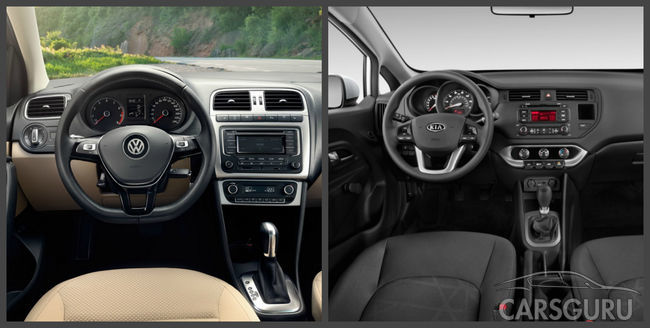
Appearance
The Rio hatchback has an eye-catching appearance: a slightly raised rear end goes well with the smooth contour of the body. Its headlights are large and have an Asian shape - slanted and stretched towards the wings. The radiator grille is narrow, it harmonizes well with the air intake in the bumper. On the sides of the car there are stamped curved lines. The rear roof pillars are slanted and there is a spoiler on the fifth door. Large lanterns have a high landing.
Volkswagen Polo has a restrained design, dominated by straight lines. The roofs of the front and rear pillars have small angles. The radiator grille is narrow, decorated in the center with the brand's logo. A wide air intake appeared on the bumper, and there are quadrangular lights behind the body. On the roof, just like the KIA, there is a spoiler.
Comfort
Both models have budget segment almost the same interior space. The Polo is somewhat more modest than the Rio: hard plastic in minimalistic colors against glossy black plastic. The dashboard of the Rio looks more attractive than the Polo. It is bright and informative, especially it is decorated with a liquid crystal display in the center. The KIA Rio steering wheel has many additional options, including phone and radio control. In the top version, the steering wheel is trimmed with leather and has a heating function.
First idea budget car caught in Ford and in 2002 they began issuing a truly popular Focus models. This hatchback, and more often a sedan, annually became the best-selling car in Russia, until the budget wave was picked up by Renault. Their Romanian sedan Dacia Logan under a French brand pleasant to the Russian ear, they began to assemble since 2005 at the newly opened Avtoframos plant in Moscow.

As it turned out later, before the start of the financial crisis of 2008-2009, the idea of creating a cheap car for rapidly developing countries was nurtured in three more countries. automotive companies- Volkswagen, Hyundai and Kia. Now, when the consequences of economic stagnation have not yet subsided, these models have come in handy. The first to appear was the people's Polo sedan, which immediately became a bestseller in the B+ class. But after a few months, a direct competitor began to step on his heels Hyundai Solaris, now holding the undisputed leadership in the number of cars sold, three times the Polo. Now the Solaris are assembled in three shifts in the hope of producing 13 thousand cars by the end of 2011, but the queues have already stretched for more than a year.
However, another tool was being prepared in the Korean concern Hyundai-Kia, which was also dubbed “a car designed specifically for Russia,” although China remains the main market for the new sedan. Instead of the name K2, assigned to the model in the Celestial Empire, the Russians chose the more familiar one - Rio, because such a car has already been sold with us and has proven itself well.

We decided to bring all three newly minted sedans together in order to find out who is more likely to influence the balance of power in the youth-budget segment of cheap foreign cars, and also what it is better to give your accumulated or not your credit money for.
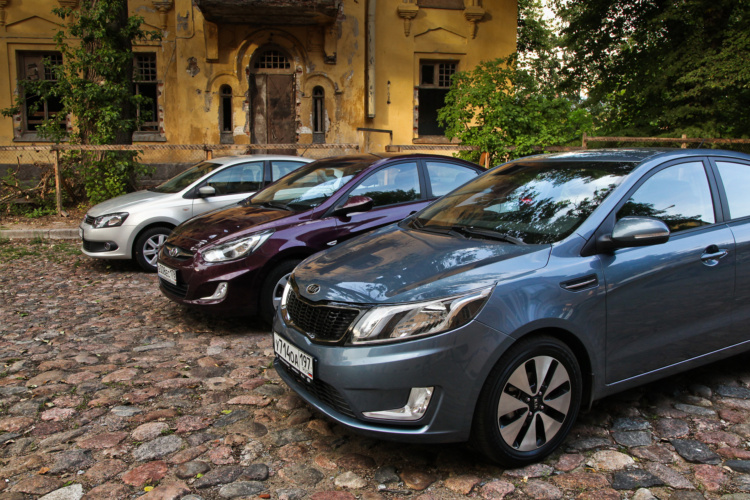
All three cars are equipped with 1.6-liter gasoline engines: the VW Polo has a 105-horsepower “four” with a maximum torque of 153 Nm, under the hood and Hyundai Solaris hiding a more powerful 123-horsepower engine with a maximum thrust of 155 Nm. But the German unit requires less speed to reach both peak values, so the difference is almost not manifested in dynamics, although the passport overclocking german car the slowest.

The Solaris sedan is the most fervent of all, because it is the only one of all the participants that is equipped with a five-speed mechanics, and the torque converters of the other two rivals steal too much energy from the engines. But in Polo, the “automatic” called Tiptronic has six steps, instead of four Korean ones, and is therefore more economical: fuel consumption on the highway does not exceed 6.8 liters per 100 kilometers, and in the city it rises above nine only in rare cases in traffic jams.
Acoustic comfort is better thought out in Hyundai and Kia - other things being equal engine compartment Polo sedan insulated worse, and the sound of the engine even on low revs makes you remember the rattling of diesels, oh, if only their throttle response. In Korean twins, the ears are much more comfortable, the engines begin to howl only at high revs characteristic annoying rumble, after which you don’t want to go to the next overtaking, especially with the Kia “automatic” it is twice as difficult to do as with the Hyundai “mechanics”. In this standings, the German sedan has an advantage - the same Tiptronic, that is, a manual gearshift mode that allows you to prepare the car in advance for a maneuver.

![]()
Polo and Solaris are boring to drive, their steering wheels dangle sluggishly from side to side at any speed, and there is no question of adequate car reactions. Kia has the same problem, but the car instills an imaginary confidence in the driver, since the “steering wheel” of the Rio is filled with a pleasant effort, which, however, is lost with increasing speed. Besides rear shock absorbers on all Kia they are tougher than on the second “Korean”, because on Hyundai they started to install only from August 15, and our test copy was released earlier. Otherwise, the entire structure of the "Koreans" is the same: MacPherson struts in front and a torsion beam in the back.


The VW Polo has the same scheme, which is why it is unpleasant to drive through pits and potholes on all three cars. But Kia and Hyundai literally burst at the seams when they meet with a tall and “rude” speed bump, while Volkswagen Polo of the last strength, it holds the onslaught of unevenness, and its suspensions give a dull blow to the racks at a higher speed than that of the "Koreans".

Rio with Solaris has something to answer: they slow down better, because all the brakes in these cars are disc (front 256x22 mm, rear 262x10 mm), while Volkswagen has rear axle drums are installed, and absolutely in any configuration, including the top-end Highline. Not the last role is played by tires of maximum Kia equipment- Kumho Solus KH17 size 195/55 R16, which are installed as base on Ford Fiesta and Focus, Volkswagen Polo and Golf hatchbacks, as well as Opel Corsa and Astra in Europe. In order to save money, Volkswagen had to turn to domestic suppliers and choose the Kama Euro brand. Plus, alloy wheels for the Polo are only available in the top version, and our copy had steel “tags” with hubcaps.
We will not judge the appearance, although this is one of the main parameters that the client first of all pays attention to when making a difficult choice of purchase. Someone likes the flowing lines of the Hyundai, others - a stern and stately, almost like a Phaeton, external Polo view, but one thing is clear: Kia Rio is the freshest car so far, skillfully drawn the chief designer of the brand, Peter Schreyer.
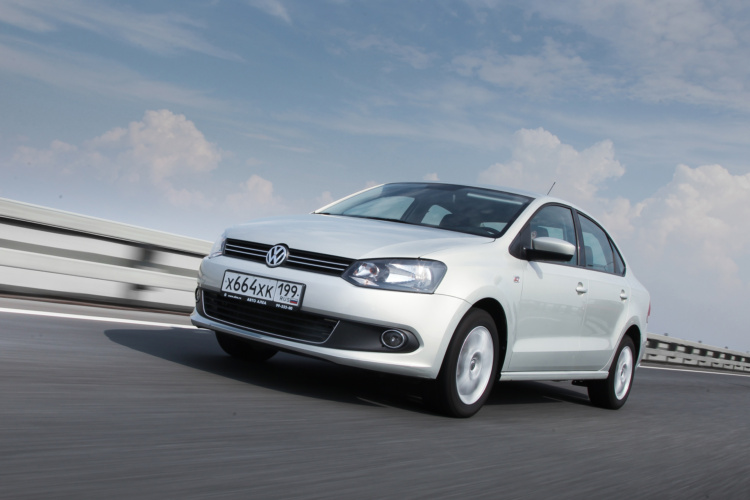
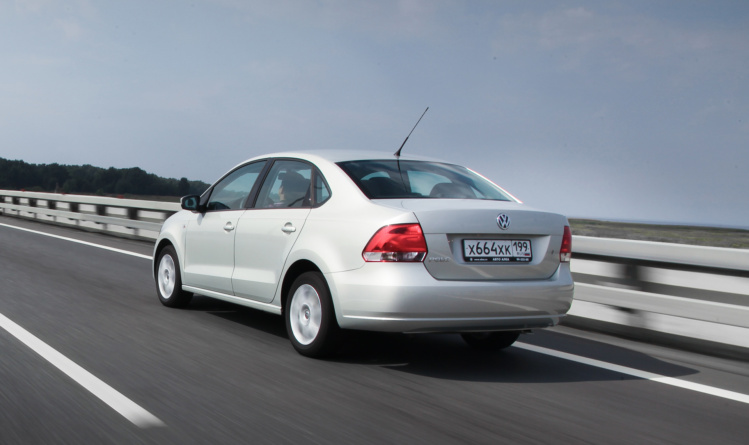
Despite the visible differences in appearance, the "Koreans" from and to are similar to each other in the structure of body panels. We are sure that if you remove the hood, headlights, bumpers from the Kia Rio, all of them can be easily reattached to the Hyundai Solaris without buying additional adapters and mounts. It is possible that Chinese manufacturers auto junk will soon release headlight units and false radiator grilles, which will allow you to substitute Solaris parts instead of Peter Schreyer's "tiger smile" and vice versa.
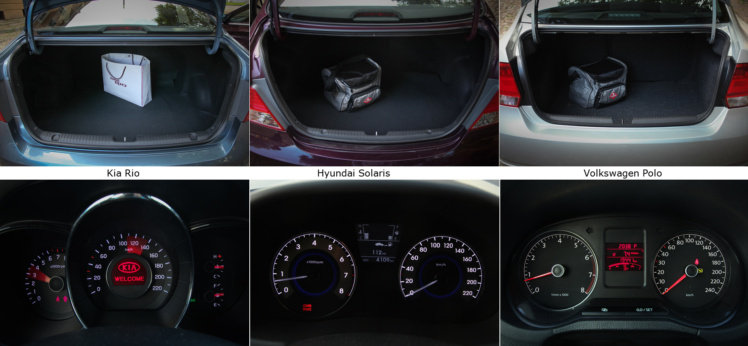
The main difference between the "Koreans" is the feed, which in the Kia Rio sticks up a little more than in the Solaris, and gives an advantage in volume luggage compartment: 500 liters versus 454, respectively. Volkswagen trunk The Polo holds 460 liters of luggage, but thanks to the lower loading height, the German sedan is easier to pack. The Polo opening is the same as the Rio, but if you fold the backs rear seats, then the hole formed behind them in the “German” is wider than the identical ones for the “Koreans”, and a flat floor is not obtained in all three cases, however, the seats of the “Koreans” fall a little lower. But only Kia has a button on the trunk that allows you to open it without the help of a key and a key in the cabin - a trifle, but extremely convenient, and there is not even such a button on the Solaris key fob, you can only open the trunk from the passenger compartment.

Sitting at the back is more comfortable in the Polo, the distance to the backs of the front seats is clearly greater here, although the distance between the axles speaks in favor of Solaris and Kia (+18 millimeters). But in the driver's seat, everything is different - landing and feeling of comfort in all three cars are different. Volkswagen - the standard of ergonomics in budget class, the steering wheel here is adjustable in four positions (for the “Koreans” only in height), the seats have at least some lateral support and a longer pillow, the left hand can be easily placed on the wide door armrest, and in Kia and Hyundai only the “window sill” saves . The "German" is contradictory in detail, it has a one-touch turn signal mode - an extremely useful option, but there is no adjustment of the dashboard backlight in any of the configurations. Strange, isn't it?

Kia Rio and Hyundai Solaris are a youth version, and the point is not only in bold design, but also in equipment. The top-of-the-range Korean newcomer Premium package offers everything the modern buyer needs: 16-inch alloy wheels, heated windshield in the “rest” zone of the windshield wipers, repeaters of direction indicators in the mirror housings, a beautiful Supervision dashboard, a black lacquered center console and a panel near the wings, six airbags, a stabilization system, climate control, heated front seats, an engine start button, an audio system with USB and Bluetooth, multifunctional steering wheel with leather trim and even leatherette dashboard trim! Exhaled? Indeed, with all these options, Kia Rio looks a class higher than it really is.

Against the background of the Rio sedan, not only the Volkswagen Polo is lost, in which you have to pay extra for the stabilization system in the top Highline equipment, but also the Solaris twin. Kia Rio really looks and feels more modern and premium than its competitors. It remains to find out the price of all this luxury, which will be announced on September 1. Following the policy of Hyundai-Kia, the new Korean model should cost a little less than the Solaris, but with leather dashboards and with a full range of options, the price of "Rio" can completely surpass its fellow platform. But even if this is so, similar in Volkswagen configuration Polo costs 675 thousand rubles, and the top solaris sedan with "automatic" - 639 thousand. Almost parity.

Summing up, we give the first place to the Kia Rio sedan with an “automatic”. This car looks the best on the inside, is the richest equipped and is not inferior in terms of Volkswagen dynamics Polo with 6 speed automatic transmission. "German" is thought out in those little things that customers pay attention to only after they have already made a purchase. It is better than its competitors in the everyday sense, more comfortable on bumps, more convenient in terms of driver and passenger accommodation, but such shortcomings as annoying engine noise, “empty” steering wheel, mediocre dynamics put it half a step below the Korean leader.

Despite the fact that Hyundai Solaris is a twin of Kia Rio, it takes the last place in almost all respects, completely losing to Kia in all classifications. In this case, we turn a blind eye to the fact that the Solaris sedan is equipped with manual transmission, as we can transfer all its driving qualities from Kia Rio in absentia.

By the way, Kia "Rio" has one more indisputable advantage: orders for this sedan are not yet accepted, there are no prices, which means that if you hurry up and reserve one of the first cars, starting from September 1, you can get it already this year, unlike the other two competitors.
UPDATE: Finally, there are prices for Kia sedan Rio. The basic version with a 1.4-liter engine with a capacity of 107 horsepower and a five-speed manual transmission will cost 460 thousand rubles. For a 4-speed automatic will have to pay 40 thousand!
Not bad, considering that the platform Solaris costs from 399 thousand rubles, and the Volkswagen Polo 1.4 5MKP - from 424.7 thousand. The price difference in Kia is explained by the fact that the Rio sedan has richer equipment in the basic configuration: air conditioning, 40:60 folding rear sofa backrest, two airbags, ABS, daytime running lights. For exactly the same Hyundai Solaris in Optima configuration with air conditioning and the "Advanced" package, you will have to pay more - 483 thousand rubles.
Kia Rio with a 1.6-liter engine with a capacity of 123 horsepower"Mechanics" and complete set Luxe will amount to 520 thousand rubles. Performance Prestige 1.6 is estimated at 568 thousand rubles, and top version Korean sedan 1.6 Premium with "automatic" will cost 660 thousand rubles.
Volkswagen Polo sedan crash test

At the end of 2010, the Autoreview edition conducted the first crash test of the Volkswagen Polo sedan. Kaluga assembly. The car managed to earn the most points in the history of the newspaper's tests, earning 14.3 points, according to the methodology Euro NCAP. The four-door modification was only 0.7 points short of the results of the European hatchback, which received five stars in the overall rating in the Old World.
Hyundai Solaris sedan crash test

In the August 30 issue of the newspaper Autoreview, the Hyundai Solaris sedan was also tested for safety. The situation is ambiguous, since in the first crash test the car was able to earn 13.2 points for the safety of adult passengers, but this is at a collision speed of 61 kilometers per hour, while 64 kilometers per hour is required. The test, conducted by Russian journalists in the Czech laboratory TUV SUD, gave Solaris only 8.2 points, equivalent to two Euro NCAP stars, which went into the offset. As a result, Solaris, as well as its clone in terms of power structure Kia bodies Rio, in terms of safety, are significantly inferior to the Volkswagen Polo.
Facts and Specifications:
|
Hyundai Solaris |
Volkswagen Polo |
||
| Dimensions mm (l/w/h) |
4370/1700/1470 |
4370/1700/1470 |
4384/1699/1465 |
| Wheel base mm |
2570 |
2570 |
2552 |
| Trunk volume l | |||
| ground clearance mm | |||
| Engine, obm l |
L4 1.6 |
L4 1.6 |
L4 1.6 |
| Engine power hp |
123 at 6300 |
123 at 6300 |
105 at 5250 |
| Maximum torque Nm |
155 at 4200 |
155 at 4200 |
153 at 3800 |
| Transmission |
4 automatic transmission |
5 MCP |
6 AKP |
| Tires |
195/55 R16 |
195/55 R16 |
195/55 R15 |
| Curb weight kg |
1218 |
1110 |
1217 |
| Max speed km/h | |||
| Acceleration 0-100 km/h |
11,2 |
10,2 |
12,1 |
| Fuel consumption l (combined / city / highway) |
6,5/8,6/5,2 |
6/7,9/4,9 |
7/9,8/5,4 |
Budget boom?
Russia is among the emerging economies of the BRIC group, which includes Brazil, India and China. For all these markets, many automakers are trying to develop a budget option for cars. Therefore, it is no secret that the main character of the test - the Kia Rio sedan - was actually developed for China, where it is sold under the name K2. Despite the high degree of localization manufactured by Volkswagen Polo in our country, exactly the same sedan is sold in India under the name Vento, and Indians are also told that it was made exclusively for them. Hyundai sedan Solaris replaced the Accent model in our market, its analogue is in China (Verna), in the USA and Korea (Accent), as well as in other countries.
About the desire to bring to Russia budget sedan many companies spoke formally and informally. What can come to us in the near future?
It is quite possible that Toyota Etios, a sedan originally designed for India and sold there since the beginning of 2011, will soon enter our markets.
The head of Nissan, Carlos Ghosn, has repeatedly said that the company entrusted to him will create a budget model for Russia, it could again be a sedan sold in India. Nissan Sunny(in the USA Nissan Versa).
On readiness to release Russian market a cheap sedan was also mentioned in PSA Peugeot-Citroen. They already had experience - model 206, but domestic customers did not accept it.
After losing the sedan Chevrolet Lanos (Daewoo Lanos) and the transfer of rights to its production to the Ukrainian plant ZAZ (now it is called ZAZ Chance), General Motors was left without a cheap sedan. "Special for Russia" can become Chinese Chevrolet model Sail, created jointly with the SAIC holding.
Concern Ford dreams of creating a sedan for emerging markets on the platform of the Focus model.
the site thanks the car dealership "Vostok-Auto" ( official dealer Hyundai) for providing for a test drive Hyundai car solaris.
#Upon closer inspection, the assembly of the car upset me - these are uneven gaps of body elements, el. electrical tape wiring (no hint of heat shrinkage), frank marriage of plastic trim panels and the like.
Rideability: I've read before that Kia suspension Rio is harsh, but I made sure that it is just oak. Yes, small pits and cracks on the road, the car runs fine (the suspension swallows) it only gives a booming sound in the cabin, due to the complete absence of noise and vibration isolation, but on the road marked with the sign 1.16 “Rough road”, and we have this everywhere, the car jumps and dangles like a garden cart (probably due to the short stroke of the shock absorber). The pendant is oak, but at the same time it breaks through at once, at the very first “penetration” on a hole hidden under water in the cabin, it creaked, what a shame it was that after reseeding from the VAZ due to squeaks and rattling, I got the same thing, only in twice as expensive. In general, with a run of 100 km, the interior already creaked like an old cart, with the VAZ it happened much later - with a run of about 50 thousand km. The seats of the second row creak, or rather the places where the backs come into contact with the rear shelf, and the shelf itself is like a rattle (it will need to be glued with something). Why??? Is it really such a thin metal that the car “breaks” on a rough road. This outdated "beam" rear suspension design. I read earlier that Solaris in the first issues suffered from the rear suspension (shaking the back), and Kia Rio allegedly took into account such flaws, but apparently they did not go far. At a speed of 130 km / h, the car roars, the steering wheel becomes light and not informative, while the VAZ behaved more worthily on an uneven road, the VAZ seemed to hang over the road, only the suspension worked, and the Kia Rio jumps like a jumper.
The Kia Rio is also dirty - it splashes mirrors and door handles, it lacks any molding along the side so that splashes of dirt on the spring road do not cover the door handles. After a trip along such a road, you can’t touch the handles so as not to get dirty, the aerodynamics are poorly thought out, the spray flies above the door handles and the car is blown away in the whirlwinds of heavy vehicles, however, the same story with the VAZ.
- I was pleased with the backlight of the trunk, and the trunk itself is quite roomy
- The pendant is oak and at the same time breaks through at times
Review of Kia Rio 1.6 (Kia Rio) 2012
I’ll start the review with the fact that my wife actually drove the car, although I also had a chance to wind a couple of thousand kilometers on it. For those who read my review about the VAZ-2112, I will say that in principle my approach to the car (not just as a way of transportation) has not changed, but caution has been added)) Zhenya, by the way, is also pleased to sit behind the wheel, which, in fact, determined the choice of configuration - the most powerful engine and "mechanics".
So, let's start, as usual, with the pangs of choice. It was made up of cars. price category“About 500 tr”, quite frisky, beautiful (for a girl, after all)), not microvans and not very expensive to maintain. There was also a thought about the trunk - but, as life showed, my wife didn’t really need it, it was filled twice a year with a replaceable set of rubber, and even once when it was necessary to pick up friends from the airport. We sat in Rio, Solaris, Polo-sedan, Pyzh 308th and Chevy Cruz (though both are slightly used), Lacetti, there were still some Japanese, it seems - they usually don’t stay in my head, they’re all boring, except for the Civic, perhaps, but it is more expensive. Cruz was dropped due to unrealistic maintenance and parts costs (according to various sources, maintenance cost at least twice as much as for any of the other cars on this list). Solaris seemed somehow clumsy, and the employees of the Autoreview newspaper frightened, who noticed behind the first Solaris a tendency to dance booty at completely “free” suburban speeds. The wad would have been more powerful, but there were a lot of rumors about the unreliability about the 150-horsepower turbo engine from Mini. Lacetti was already a bit old and not feminine at all. Well, the Polo is super, of course, but the girl chose Rio - it is both livelier and prettier, and we didn’t know then the problems that we would face ... Now I would definitely choose the Polo (better hatch), in this category, well, or I would have waited for the Skoda Rapid (the trunk of a sedan turned out to be needed very rarely, but it interferes with parking in the city!). By the way, the machine on the test drive was very upsetting, so they didn’t even think about it - until it decides to switch down, I already need to go up, because there was nowhere to rebuild ... it’s a pity, such a motor disappears!
In general, we were happy with the purchase for a long time! The motor is just a song, the box switches like clockwork, and with small lever strokes and almost without effort, for my taste, it’s even too easy (just don’t say at this point that everything is easy after the VAZ - I’m on different machines went! but this one really has a “light” gearshift lever). The interior is comfortable, there are all sorts of shelves, drawers, cup holders, even a torpedo over beautiful and comfortable devices such as leather upholstered. All buttons are illuminated, heated wipers, mirrors, seats, climate … everything works well. The trunk is good, your set of tires fits without problems.
Strengths:
- Motor
- Design
Weak sides:
- Body
- Suspension
Review of Kia Rio 1.6 (Kia Rio) 2011
In January of this year, I exchanged the Priora Suite for this Rio with an additional payment of 190 tr. Options prestige (pre-maximal speed on the mechanics). ABS, power steering, climate control, heated mirrors, parking areas for windshield wipers, seats, multifunction steering wheel, mp3, usb., 6 pillows, armrest, eyeglass case. Machines are different .. earth and sky. In rio, compared to prior, silence. Plus made a complete insulation of the cabin.
Essentially about the car: the car is a copy of Solaris, assembled in Russia on the same conveyor. The car is small B class, but the cabin is spacious enough. Chain motor 1.6 16 valves, 123 forces and 155 N.m of torque. There is a phase shifter on the intake camshaft, thanks to which the engine starts to run from 2000, unlike the Prior, which only starts to accelerate after 3000. According to the general impression, the engines of the rio and the priors are the same in dynamics (the prior is 100 kg lighter). The gears in the gearbox are switched very clearly, the linkage is cable, the shifts are similar to the reference ones like in the Ford Focus 2. gear ratios they are perfectly matched, but 6th gear is missing. On 5th at 3000 rpm, the speed is only 105 km / h. On other Kia and Hyundai models, gearbox 6 tbsp. In 2014, Rio began to be produced from 6st. mechanics. Consumption in the city of 11.5-12.1 liters. On the highway at 120 km / h 9.2. I think the cost is very high. I don't drive in the city. Priora in the city spent 9.0 and on the highway 5.4-6.1 liters. The data is not from the ceiling, but personally verified.
On the standard wheels 185\65\15 ground clearance decent. The front suspension is simple, reliable on the subframe, does not knock even at 74,000 mileage. There is nothing to break at all at the back. There is a beam. But there are claims rear suspension. Suspension travel is very small. With 2 passengers behind on speed bumps, it shakes very hard to the bumpers .. the shock absorbers are working. The rear suspension on the prior is definitely better. At a speed of 110 rio, you have to taxi .. the rear starts to walk .. especially on rough roads. It gives the impression of a dangerous machine. Attention: the body geometry is in order, the convergence and camber of all wheels are normal. Definitely a design miscalculation on the rear suspension. With nostalgia, remembering the reference focus suspension.
